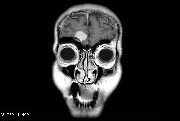Learning Objectives
- Dementia in patients less than 65 years old may be caused by Alzheimers disease, frontotemporal dementia, normal pressure hydrocephalus, trauma, Huntingtons, neoplastic disease, leukodystrophy, lysosomal storage disorder, metabolic encephalopathy, stroke or infection.
- Frontotemporal dementia affects younger patients, and may show symptoms of language or behavioral disorders
- The PET scan is used to help make the diagnosis of FTD
History
GF, a 58 year old right-handed man, is brought to your office by his girlfriend. She has known him for 10 years. She is concerned about new habits he has developed over the past year. These include arranging the kitchen appliances and utensils in the middle of the night and folding the dirty laundry. He seems to use words inappropriately sometimes and he recalls names poorly. Although GF remains a socially active person, she says he is not as close to his friends as he once was, and he seems to forget outings and parties. GF says he has less interest in these things, and dismisses his habits as “flavors of his personality”.
GF takes no medications. He has no allergies to medications.
He has a medical history of basal cell carcinoma and appendectomy.
He has a family history of coronary heart disease in his father and Alzheimers disease in his mother (she is 86 years old). He has no brothers or sisters.
GF is a retired executive. He does not smoke or drink. He exercises regularly.
A review of systems is negative for headaches, visual disturbance, smell or taste disturbance, trouble swallowing or choking, trouble breathing, chest pain, joint pain, rashes, bowel or bladder incontinence, or symptoms of paranoia.
Examination
GF is a fit, youthful-appearing man, dressed in gym clothes. He has a pulse of 68. His blood pressure is 122/72. His cardiovascular exam is normal. His pupillary and funduscopic exams are normal. He is able to answer questions, although his answers are incomplete at times. He has normal orientation and awareness. When he is asked to name objects in a picture, he names less than half of them correctly. When he makes a mistake, he smiles and manufactures an answer. His ability to calculate is normal. He makes 2 mistakes when asked to repeat 10 words. He is able to draw a detailed clock face accurately. His cranial nerve examination is normal. He has normal muscle strength and tone. His deep tendon reflexes are normal. He has normal sensation to vibration in his hands and feet. Sensation to pinprick is also normal. He has normal finger-nose-finger movements. He has a normal Romberg and a normal gait.
Localization and Neuroanatomy
GF is a middle-aged man who presents with behavioral and language disturbances. His examination shows deficits of naming and repetition, indicating dysfunction of the left posterior frontal lobe, near Broca’s area. Behavioral changes localize to the anterior frontal lobe on either side. Based on the exam, it appears that corticospinal, somatosensory, auditory and visual pathways are spared.
Diagnosis
Symptoms of dementia in a person less than 65 years old are uncommon. There is a wide ranging differential diagnosis for these symptoms. Alzheimers disease may occur in people of this age. When it occurs at ages less than 60, it tends to affect family members with presenilin 1 or 2 mutations or in patients with Down syndrome. Frontotemporal dementia is possible. This disorder often causes symptoms affecting behavior or language. Huntingtons disease and neoplastic disease are possible. NPH, stroke, infection, mitochondrial disorders, leukodystrophies, and lysosomal storage disorders are also causes of dementia in patients under age 65. Although not all of these illnesses would be suspected of causing this patient’s symptoms, it is possible that focal disease of the frontal lobe could be the cause, and for that reason, a work up is recommended.
In this case, it would make sense to obtain a brain MRI for further determination. This would help to show if stroke, infection, neoplasm, NPH or leukodystrophy was the cause. In appropriate cases, blood testing for metabolic disorders and CSF analysis may also be helpful. A neuropsychological battery can be helpful when exam details are inconsistent or vague. A cerebral PET scan is recommended for distinguishing frontotemporal dementia from Alzheimers disease. For each of these disorders, characteristic patterns of hypometabolism may appear on the PET images which are diagnostic for each of these disorders. Although the PET scan is generally not recommended for a routine case of Alzheimers, it is recommended for the diagnosis of FTD.
Treatment
The nonmedical treatment of dementia may include protecting personal rights, wishes, and property, continuing good nutritional and exercise habits, and maintaining social activity. Sometimes occupational therapy is helpful. Debilitating psychiatric symptoms may benefit from antipsychotic treatment, but this is rarely necessary. At this time there is no medical or surgical treatment of frontotemporal dementia.
Review Questions
- A 55 year old adult presents to your clinic. They seem to have symptoms of dementia, but no language deficits. You form a differential diagnosis. Which of these lists of possible diagnoses would you think appropriate for this case?
a. stroke, frontotemporal dementia, uremic encephalopathy, transient global amnesia
b. Alzheimers disease, Huntingtons disease, glioblastoma multiforme, myasthenia gravis
c. creutzfeld jakob disease, borderline personality disorder, Alzheimers, frontotemporal dementia
d. Alzheimers, frontotemporal dementia, thyroid encephalopathy, post traumatic encephalopathy
e. peripheral neuropathy, toxoplasmosis, limbic encephalitis, normal pressure hydrocephalus - Key features of frontotemporal dementia include
a. memory disorder and hyperreflexia
b. language disorder and personality aberrations
c. paranoia and parkinsonian features
d. encephalopathy and receptive aphasia
e. memory disorder and visual symptoms - An important test for differentiating Alzheimers from Frontotemporal dementia
a. metabolic profile (blood tests)
b. brain MRI
c. CSF analysis for tau protein
d. PET scan of the brain
e. EEG
